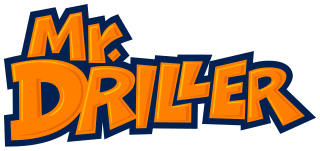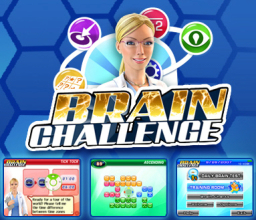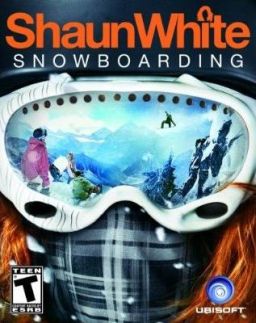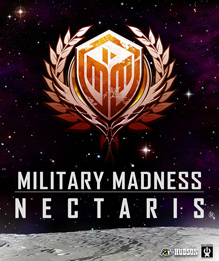
Mr. Driller is a puzzle video game franchise created by Yasuhito Nagaoka and Hideo Yoshizawa for Namco. The eponymous first game was released in 1999 for arcades and several home consoles, such as the PlayStation. Gameplay in the series consists of controlling Susumu Hori, the titular Mr. Driller, or one of his friends and destroying colorful formations of blocks to make it to the bottom of a well. In order to survive, players need to collect air capsules to replenish their depleting oxygen and avoid being crushed by falling blocks.
WayForward Technologies, Inc. is an American independent video game developer and publisher based in Valencia, California. Founded in March 1990 by technology entrepreneur Voldi Way, WayForward started by developing games for consoles such as the Super NES and Sega Genesis, as well as TV games and PC educational software. In 1997, they relaunched their video games arm, placing the company as a contractor for publishers and working on a variety of licensed assets.

Line Rider is a browser game or software toy, with versions available for Microsoft Silverlight, Javascript, Windows, and Flash. It was originally created in September 2006 by Boštjan Čadež, a Slovenian student. Soon after its initial appearance on DeviantArt, Line Rider became an internet phenomenon.

Puzzle Quest: Challenge of the Warlords is a puzzle video game designed by Steve Fawkner for Australian game developer Infinite Interactive and published by D3 Publisher in 2007. The game combines role-playing with tile-matching elements. Taking place in a high fantasy setting, the player moves his or her character around the game's world and encounters monsters and other enemies to fight so as to gain experience and acquire treasure as in a typical role-playing game. Combat takes place on a board similar to Bejeweled, and by making matches of colored gems, the combatants can cause damage to their opponents, cast spells, or perform other abilities that affect the flow of the game.

The Mushroom Men video games were developed for Nintendo DS and Wii systems. Both games were developed by American company Red Fly Studio and published by Gamecock Media Group. The story revolves around a civil war between 3-inch-high (76 mm) Mushroom Men in a human world. According to the game's designer Mushroom Men: Rise of the Fungi for the Nintendo DS is a side-scrolling platformer as well as a prequel to Mushroom Men: The Spore Wars, the Wii version, which is a full 3D platforming game. Red Fly Studio used Gambitious to try to crowdfund a sequel, known as Pax's Truffle Trouble for PC, which eventually came out on Steam as Mushroom Men: Truffle Trouble on March 10, 2015.

George of the Jungle and the Search for the Secret is a platform video game based on the animated television program George of the Jungle.

Brain Challenge is a mental exercise video game, featuring "brain exercise puzzles". The game was developed by Gameloft Beijing for mobile phone and iPod and released on September 5, 2007. In 2008 was followed by a Nintendo DS version on January 8, an Xbox Live Arcade release on March 12, and a PlayStation 3 launch on November 27. The N-Gage 2.0 version was released on the day of the service's launch, April 3, 2008. A version for WiiWare was released in autumn 2008 on all three regions. The Wii version also uses Miis for the players profile. OnLive also had launched their new streaming game platform with Brain Challenge on July 27, 2010. The game was released for Mac OS X in January 2011.

Roogoo is a downloadable puzzle video game for the Xbox Live Arcade and Microsoft Windows developed by American studio SpiderMonk Entertainment and published by SouthPeak Games. The game is followed by Roogoo Twisted Towers (Wii) and Roogoo Attack.

Bomberman Blast is an action game developed and published by Hudson Soft for the Wii and WiiWare as part of the Bomberman franchise. The game was released as two versions: a fully featured retail release and a WiiWare version known as Wi-Fi 8-Nin Battle Bomberman. The retail version was released in Japan on September 25, 2008, while the WiiWare version was released on September 30, 2008. The WiiWare version was released in Europe on September 12, 2008, and in North America on September 29, 2008.

Skate It is a skateboarding video game developed by EA Montreal, Exient Entertainment and EA Black Box for the Nintendo DS, Wii, and iOS. The game is a spin-off of 2007's Skate and was released in 2008.

Shaun White Snowboarding is a snowboarding video game developed by Ubisoft Montreal and published by Ubisoft for Nintendo DS, PlayStation Portable, Wii, PlayStation 3, Xbox 360, PlayStation 2, Microsoft Windows and Mac OS X.

Tetris Party is a puzzle video game by Hudson Soft for WiiWare. An installment of the Tetris series, the game supports the use of Miis and the Wii Balance Board, and features both local and online multiplayer in addition to several single-player modes unique to the game.

Bubble Bobble Plus! and Bubble Bobble Neo! are remakes of the 1986 arcade game Bubble Bobble. The games were developed and published by Taito. Bubble Bobble Plus! was released for WiiWare in Japan on February 10, 2009, in the PAL regions on April 10, 2009 and in North America on May 25, 2009 while Bubble Bobble Neo! was released on the Xbox Live Arcade download service for the Xbox 360 in Japan on August 5, 2009 and in North America on September 16, 2009.
Rainbow Islands: Towering Adventure! is a video game developed by Taito for WiiWare and Xbox Live Arcade. It is the latest installment in the Rainbow Islands series. The game was released in Japan on March 3, 2009, in the PAL regions on May 8, 2009 and in North America on June 15, 2009. The Xbox Live Arcade version was released on October 28, 2009.

Military Madness: Nectaris is a turn-based strategy game developed for WiiWare, Xbox Live Arcade and PlayStation Network by Hudson Soft. It is the latest game in the Nectaris series, and an enhanced remake of the first game.

Zen Pinball is a series of pinball machine video games for iOS and the PlayStation 3 developed by Zen Studios. The iOS releases are two separate applications, each containing one table; Zen Pinball: Rollercoaster, released July 7, 2008, and Zen Pinball: Inferno, released October 31, 2008. Zen Pinball for the PlayStation 3 was published by Sony Computer Entertainment and features four tables, plus an additional six tables as downloadable content. It was released on the PlayStation Network on May 14, 2009. It is the non-Microsoft counterpart to the Pinball FX series on the Xbox 360, and the first pinball game on the PlayStation 3. The game was also released on Android devices as Zen Pinball THD on December 1, 2011, and the Nintendo 3DS as Zen Pinball 3D via the Nintendo eShop on December 1, 2011 in Europe and January 12, 2012 in North America.

Puzzle Bobble Plus!, known in North America as Bust-A-Move Plus!, and in Japan as Puzzle Bobble Wii, is a video game developed by Taito for WiiWare. It was first released in Japan on April 7, 2009, and later in the PAL regions on June 26, 2009, and in North America on July 6, 2009.

Frogger Returns is a game for the PlayStation 3 and Wii by American developer Hijinx Studios. This game is purchased from the PlayStation Store, and it was available on the Wii Shop Channel before the service ended. The game was also released as DSiWare in North America on May 18, 2010.

The Pinball Arcade is a pinball video game developed by FarSight Studios. The game is a simulated collection of 100 real pinball tables licensed by Gottlieb, Alvin G. and Company, and Stern Pinball, a company which also owns the rights of machines from Data East and Sega Pinball. Williams and Bally games are no longer available since June 30, 2018, as FarSight had lost the license to WMS properties, which has since passed to Zen Studios.

















